Psilocybe cubensis is the best-known of the Psilocybe mushrooms, a genus of mostly small, dung-loving species that produce the popular hallucinogen, psilocybin. Psilocybe mushrooms are usually microdosed. P. cubensis can be cultivated on many substrates other than dung (though dung remains its favorite), and many varieties have been either discovered in the wild or bred deliberately by growers and are now under cultivation. The varieties, or strains, vary in how well and how fast they grow, what conditions they prefer, their color, size, and shape, and in the quality and intensity of the experience they give to users.
There are a couple of possible points of confusion to keep track of.
One is that because psilocybin (and anything that contains it, including mushrooms) is illegal in most jurisdictions, there is no way to do the research that would determine exactly how these strains differ from each other biochemically. The (largely spurious) claims of different alcoholic beverages producing different effects, such as making drinkers mean verses friendly and so forth, shows that user accounts can sometimes be wrong. It’s possible that just as alcohol is alcohol, psilocybin is psilocybin, period. On the other hand, there could be a whole range of unidentified “active ingredients” in play, causing genuinely differing results. The bottom line here is “your mileage may vary.”
Psilocybin concentration does differ from one mushroom to the next, and it’s likely that each strain does have a distinctive typical potency. However, the difference is likely subtle, and there is a lot of overlap between strains due to individual variation.
Which brings us to the final caveat. Many do not differentiate between strains of P. cubensis and other Psilocybe species, discussing all of them as simply “types of shrooms,” but the difference matters because other species can have dramatically different potency, either much stronger or much weaker than one would expect with P. cubensis. Estimating proper doses can be difficult to impossible without knowing the species of mushroom in question. The most popular consumption methods for Psilocybe Cubensis are Lemon Tek and Shroom Tea.
With all that being said, here is a brief review of many of the more popular Psilocybe Cubensis strains ranked by their potency, visuals and effects, in order.
Alacabenzi
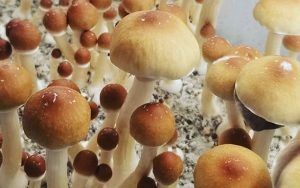

The Alacabenzi strain is, according to legend, a cross between a natural P. cubensis variant found in Alabama and another variety, possibly the species P. mexica. It produces very large fruiting bodies and is considered easy to grow.
Users report that it provides a relatively gentle trip, similar to come cannabis strains, and good for beginners—except it can cause serious problems with physical balance, especially at higher doses.
Albino A+
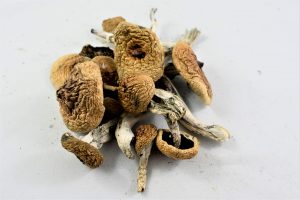

Albino A+[i], or AA+, as it is sometimes called, is typically cream-colored to white, sometimes with a bluish tint—it bruises blue very obviously when damaged. The strain is not a true albino, despite the name, but is, rather, leucistic, meaning it has reduced pigmentation, not none at all. The spores are usually the typical Psilocybe purple-black. When mature specimens drop their spores, the stem-ring may appear black with them. There is also a more typically-pigmented strain called A+, but it is not as popular.
Albino A+ is sometimes said to be part-Panaeolus, which is likely impossible (species from different genera usually can’t hybridize), but the rumor reflects the fact that the Albino A+ can be somewhat Panaeolus-like in character. There may be some similar biochemistry. It’s a popular strain, very potent, and although it often grows a bit slowly, it produces large flushes.
Acadian Coast
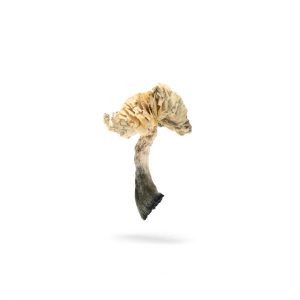

Acadian Coast Cubensis , or ACC, is rare, and not much is known about the strain—and at least some of the information available about it is unreliable. The origin of the strain has not been documented, but it’s often said to be a stabilized version of genetics originally collected somewhere on the Gulf Coast, perhaps in Mississippi or Louisiana. ACC is not a stand-out strain—it doesn’t look strange, nor is it unusually potent, it’s basically a typical cube. However, any cube is special, and this strain can produce impressive harvests in the hands of an experienced grower. Some say that this strain does much better on its second or third flush, provided that the grower can keep it going that long.
Avery’s Albino
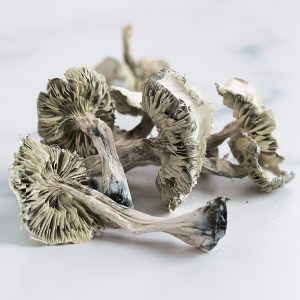

Avery’s Albino is a true albino version of either the A-Strain or Cambodian. It does look like Cambodian in shape. It’s a relatively new strain that’s becoming popular both for its ghostly white beauty and for its reportedly mellow and creative high. Potency is about average. While this strain will do well with any of the standard growing methods, its spores are usually sold, not in solution but as swabs-meaning cultivation requires the extra step of agar work. Few growers can avoid contamination during agar work until they’ve had some experience.
B+ Cubensis
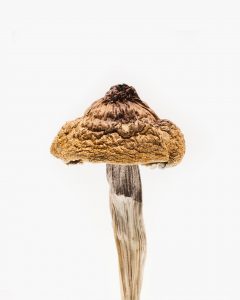

An extremely popular strain thought to have been developed intentionally by a cultivator twenty to thirty years ago—some people suspect it of being a hybrid between P. cubensis and another species, P. azurescens, rather than a pure P. cubensis strain. The fruiting bodies are relatively large, and the spores are quick to germinate. The strain is relatively easy to grow and produces a big first flush but smaller subsequent flushes.
Users report a middle-of-the road experience and a lethargic feeling, but nausea seems less common with B+ than with other strains.
Blue Meanie
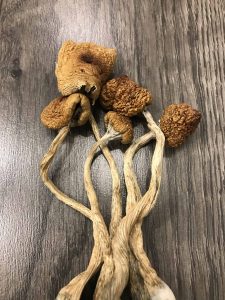

“Blue Meanie” is both the name of a popular P. cubensis strain and a common name for Panaeolus Cyanescens, a different but related species. The two look somewhat similar but not identical, and they have differently-colored spore prints. Perhaps more to the point, Panaeolus Cyanescens is dramatically more potent.
The Blue Meanie strain of P. cubensis has a bluish stem. It’s considered highly potent (for a p. cubensis) with an intensely visual, very long-lasting trip.
Burma
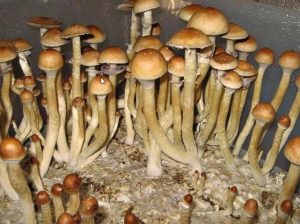

The Burma strain was, indeed, originally a natural variation collected in Burma. They are
known for their fast, aggressive growth, their potency, and their intense and enjoyable high—although
Burma trips are said to bring little of the insight credited to other strains. Growing Burma is not difficult.
Any method commonly used to cultivate Psilocybe cubensis will work for them. Colonization time can
be only a matter of days. Several brands of grow kits are available for the Burma strain, and growing
from scratch makes an engaging hobby for those who have the interest.
Cambodian
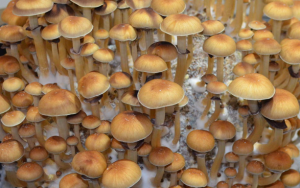

The Cambodian strain was found growing wild in Cambodia near Angkor Wat, hence its name. The fruiting bodies are small, with brown caps with pale spots. It’s a very popular strain with growers, since it grows very fast and fruits quickly, abundantly, and repeatedly. They do need slightly warmer growing conditions than most P. cubensis strains do.
Users report high potency and trips that are not intensely visual but with a lot of energy and a very creative or philosophical mindset.
Chitwan
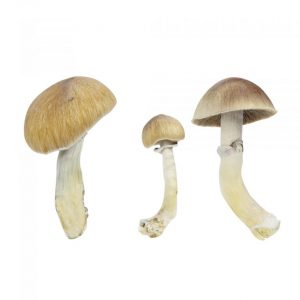

The Chitwan Strain was found in Chitwan, in Nepal, growing in either rhinoceros or elephant dung. This strain does not differ much from typical members of its species. Very little is known about these mushrooms. Its potency has not been tested, and estimates vary wildly. It is considered est for intermediate growers, not beginners, but we have not been ale to learn why.
Costa Rican
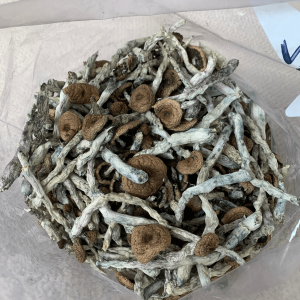

Costa Rican Cubensis[i] is a naturally-occurring Psilocybe cubensis variant now being cultivated. While Costa Rica is tropical country, this mushroom was found at high elevation and is therefore used to cooler temperatures—it can be difficult to grow, especially if the temperature isn’t right[ii]. Costa Rica cubensis mushrooms are mostly brown. The thick secondary veil tends to rip away from the stem at maturity, leaving any veil remnants on the cap edge rather than on the stem.
This strain is considered low-potency by many users, though experiences vary widely.
Ecuador Cubensis
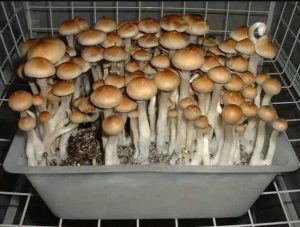

As the name implies, this one is a naturally-occurring strain originally from Ecuador. The mushroom is specifically native to the highlands of that country—the harsh growing conditions there may explain the strain’s resilience, its ability to grow and fruit with virtually any cultivation method. It’s a good option for beginners in mushroom cultivation.
Ecuador cubensis is relatively large, for a P. cubensis, with a thick stem and a caramel color. Its growth is on the slow side, but flushes are generally large. Colonization goes best at around 85 degrees Fahrenheit, with fruiting almost ten degrees cooler.
Some people describe the effects as coming on hard and fast, but then mellowing as the trip progresses. Others emphasize the mellowness overall. The experience is clean and spiritual, without much in the way of a “body high.”
Enigma Cubensis
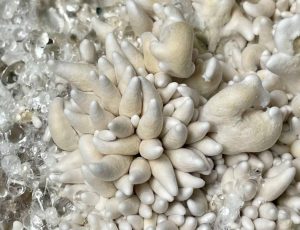

The Enigma Cubensis strain is what’s called a “blob mutation.” That means that the pins, instead of developing into mushrooms, simply fuse together and grow larger, gradually developing into a mass of dense fungal tissue. It never produces spores. Enigma must be propagated entirely by cloning. There is actually more than one Enigma strain, since the blob mutation has occurred in multiple P. cubensis strains. It’s a little unclear whether the different blobs are distinct from each other in any recognizable way.
Cultivation is fairly standard, for P. cubensis, except that it must begin with liquid culture, rather than spores, and the fruiting stage takes a very long time. The long fruiting stage does leave the grow vulnerable to contamination.
The high is pretty standard for a P. cubensis strain. The primary attraction for Enigma is simply its novelty.
Golden Halo
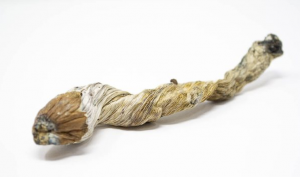

Golden Halo is unusual among Psilocybe cubensis in that it is at least rumored to have gold-colored spores. We haven’t been able to confirm the rumors—Golden Halo is a new strain with undocumented beginnings, and very little is known about it for sure—but it is said to be very easy to grow, and great for beginners at cultivation. Its psilocybin content has not been measured, but it seems to be of about average potency, based on anecdotal reports. Again, good for beginners, since an error in measurement is unlikely to result in the sort of unexpectedly big dose an inexperienced user might not be able to handle. Aside from the color of its spores, it looks like a typical cube.
Golden Teacher
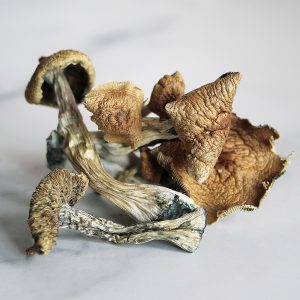

This strain produces an unusually large mushroom with a big, yellowish cap with pale spots. There are multiple stories about their origin, but they are generally thought to have been found in the wild about thirty or forty years ago. They are popular with beginner-growers, since they grow well on many different substrate types and can tolerate marginal conditions and still produce large crops. They do take a little longer to fruit than most varieties.
Golden Teacher is considered average to high potency, although the trips are often relatively short (an advantage for some users). Visuals are less intense than with some strains, but users often report a euphoric and relaxing experience, and sometimes also a sense of mental clarity.
Hillbilly Cubensis
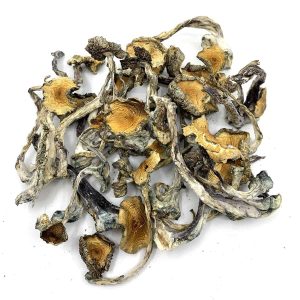

Hillbilly Cubensis[i] is a wild-occurring strain that fell out of fashion for a while, but seems to be having a come-back now. It looks more or less like most cubes, but the cap is a little smaller and has a distinct orange color, especially in the center. Because Hillbilly can be found growing in the wild, psychonauts who live within its range may be tempted to forage some for themselves—those who lack extensive experience as foragers should resist the temptation, since Hillbilly, like virtually all magic mushrooms, has a close look-alike in the all too-aptly named deadly galerina. It’s not that these mushrooms look exactly alike, but that people unfamiliar with mushroom foraging are likely to miss the difference. And that is true even for someone familiar with magic mushrooms in the hand or in a fruiting chamber. You need foraging experience—and a personal commitment to avoiding complacency—in order to know how to really notice the right details. Hillbilly is generally considered of moderate potency, for a cube strain. And as for cultivation, Hillbilly Cubensis does well with any tek normally used for cubes and is very forgiving of mistakes[ii]. It is resistant to contamination with a very short colonization time and a tendency to try to fruit inside sealed grain jars (something to avoid, but the enthusiasm is admirable)[iii].
Jack Frost
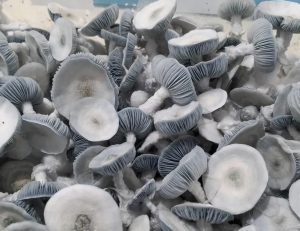

Jack Frost , as the name implies, is white (unless bruised blue by rough handling), a true albino. Not much is known about it for sure, but it is reputed to be a cross between Albino Penis Envy and True Albino Teacher, two well-known and highly popular strains. Despite its parentage, Jack Frost is not especially penis-like in shape, though it has an unusually thick stem and meaty cap. Spore production is copious and white, suggesting a sprinkling of snow. The gills are blue, an unusual feature that may or may not be related to high psilocybin content. It’s a pretty mushroom and, even among other albino strains, distinctive-looking.
Although Jack Frost has so far tested out as only medium potency, but users keep insisting it is well above. Quite possibly, this is an unusually variable strain, making dosing tricky. Almost any cultivation will work, but temperature must be kept warm and stable to get a good yield. Colonization time is a little slow and contamination resistance is only moderate, but fruiting time is fast. Spores can be difficult to source, as the strain is relatively rare.
Jedi Mind-Fuck
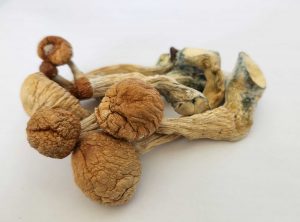

The JMF is a Psilocybe cubensis strain whose current popularity is based on an undeserved reputation for high potency. It has repeatedly tested out in the low end of the average range for its species—of course, an average cube is still pretty powerful, and users who want an intense trip can just take a bigger dose.
This strain looks like a typical cube as well, to the point that there is no way to be sure you really have JMF except to take the grower’s word for it. The strain’s most distinctive characteristic may be that it is slow to fruit and vulnerable to contamination. It’s not a good choice for cultivators new to the craft.
Lizard King
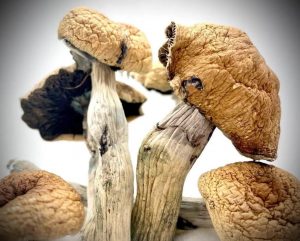

Lizard King is a strain of Psilocybe cubensis that is sometimes associated with rock star, Jim
Morrison, although the stories are conflicted and perhaps unreliable. Otherwise, Lizard King is
pretty typical as cubes go, which is by no means a bad thing. Caps are usually beige on
whitish stems. Growth is quick and flushes are often large, though colonization time is
average. Lizard King will grow on any method usually used for P. cubensis. Potency is
average or somewhat higher, and the high is known to be very mental or spiritual, without
much body load.
Melmac
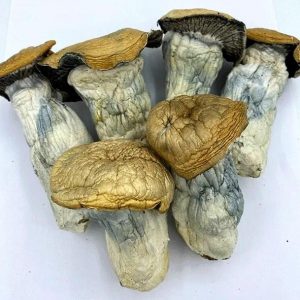

The Melmac strain of Psilocybe cubensis is named in reference to the old TV show, Alf, about a
space-alien, because this mushroom is “out of this world.” Of course, so are all other P. cubensis
strains, but it’s true this one is odder-looking than most, with a thick, contorted stem and a wavy, even
split cap. It is a close relative of Penis Envy, and the two have a lot in common, though they don’t look
much alike. It’s always a subject of debate how much different strains differ as far as their trip effects
go, but Melmac is at least said to be mellow, with a strong emotional component but few visuals. It is a
relatively high-potency strain. Melmac is easy to grow, with colonization time in the normal range,
though fruiting can be on the slow side. The only difficulty is that, like Penis Envy, Melmac drops few
spores. Cloning might be the better bet for cultivation.
Makilla Gorilla
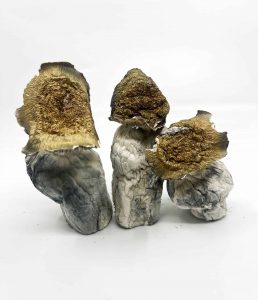

Makilla Gorilla was developed by crossbreeding Albino Penis Envy (APE) and Melmac, both derived from Penis Envy, a strain notable for its potency and…for looking like a penis, because of its very narrow cap. But Makilla Gorilla didn’t inherit the phallic look, nor is it albino. The strain produces large mushrooms with thick, meaty stems and moderately-sized caps. The stem is white or, often, bruised blue. The cap is a pale caramel color. Reportedly, the flesh of this mushroom is unusually dense, meaning doses are larger than they appear—use a scale to get the right dose size. Not much information is available about cultivating this strain.
Mazatapec
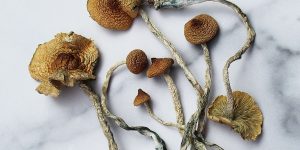

The Mazatapec strain was named after the Mazatec people of Mexico, who have traditionally used it for religious and spiritual purposes. Unfortunately, somebody added two extra letters to the name by mistake, and by the time somebody noticed, the garbled name had gotten too popular to change. Potentially adding to confusion, although this strain is Mexican in origin, it is not the same as the strain called “Mexican.” The two are similar, but not identical. Mazatapec can be a slow grower, but often produces large flushes of brown-capped mushrooms.
Mazatapec is said to be less potent than the average P. cubensis strain, but also gentler on the body, causing fewer side-effects. Its high is also said to be very spiritual, as might be expected of something originally used for religious purposes. It is a favorite of both beginners and spiritual seekers.
Orissa India
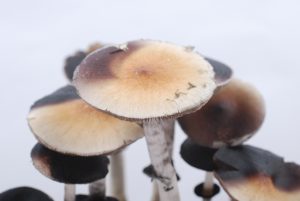

As the name implies, this strain was found growing wild in India. On its favorite substrate, elephant dung, it can produce truly huge fruiting bodies. In cultivation, it is not huge but is still large, the biggest and tallest known P. cubensis strain. The cap is brown at the center but fades to white near the edges. The stem is yellowish. It’s a good strain for beginners who want to grow magic mushrooms, since it resists contamination and tolerates poor conditions fairly well.
Users report that it is extremely potent, with a very relaxing and very visual trip.
Pearly Gates
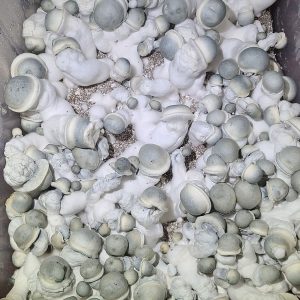

Pearly Gates[i] may be a scary name for a mushroom, but this strain is not likely to send you to the actual pearly gates. Most likely, the name reflects the pearly color of the caps. Maybe you’ll feel heavenly as well? We haven’t been able to track down the origin of the name. Pearly Gates is a cross between True Albino Teacher and Melmac, and is reputed to be unusually potent, just like its two parents. It is related to Penis Envy and shares that strain’s rather, um, mammalian shape. Also, in what sounds like part of an off-color joke but isn’t, these mushrooms can also get quite large. Pearly Gates is said to be not just high-potency but fast-acting. Expect the effects to come up in about half an hour. For growers, this counts as an advanced strain. It is slow growing. Also, it doesn’t produce a lot of spores, though it is not as bad in that respect as Penis Envy.
Penis Envy
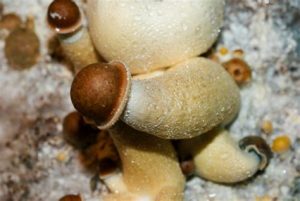

Penis Envy is a little more penile in shape than other strains, thanks to a thicker stem and a smaller, more curved cap, but it is not noticeably more envious. While its discovery is often credited to Terrence MnKenna, he only found and collected the wild progenitor; a cultivator named Stephen Pollock discovered the mutation that would become Penis Envy while working with the material provided by McKenna.
Penis Envy is a very difficult strain to grow. It drops very few spores, those spores do not stay viable very long, and they take substantially longer to germinate than most P. cubensis spores do. Plus, the mycelium is unusually vulnerable to contamination. As a result, very few growers work with Penis Envy, making the variety rare and expensive to buy. Users pay the high prices because this strain is unusually potent.
Besides the potency, the Penis Envy trip is unusual for having a notably fast onset with wavy, rather than geometric, visuals and relatively little effect on the body—the experience feels “clean,” mental and emotional, rather than physical. It is propagated and used both in pure form and as one of the parents in a number of different popular hybrid strains.
PES Amazonia
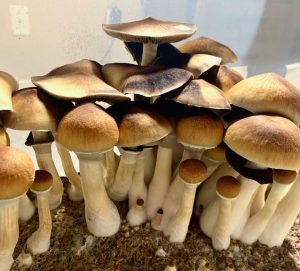

PES stands for “Pacifica Exotica Spora,” the name of the company that first offered it—though the strain is now widely available. These mushrooms do indeed originate in the Amazon. As a tropical strain, they require slightly warmer growing conditions than most, but they typically grow fast. The individual mushrooms are large, sometimes very large. Especially when young, they have reddish caps. PES Amazonian is unusually potent, perhaps one of the most potent known, yet its high is said to be less visual than that of other P. cubensis strains. Instead, it is mental and spiritual, and can be intense. The experience can last eight hours. The intense, yet somewhat atypical trips are a major reason for this strain’s potency, especially among spiritual seekers.
PF Classic
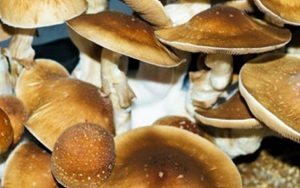

The “PF” is, according to legend, from the nickname of the strain’s developer, Psilocybe Fanaticus, who also invented PF-tek mushroom cultivation. His real name is Robert McPherson. His strain of P. cubensis is known for large, brownish caps that often get lighter in color as they get older. They take a long time to grow and are not a great choice for first-time growers but do flush repeatedly.
Users report a strongly visual experience, especially at higher doses, with a creative and introspective mood. Nausea afterwards is likely, though.
PF Redspore
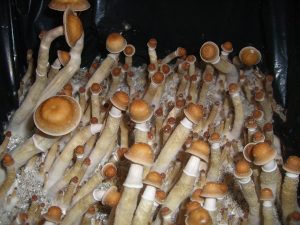

PF Redspore[i] is a variation on the PF Classic. Both were developed by Robert McPherson, who used the nickname, Psilocybe Fanaticus. That, his nickname, is where the PF comes from. The spores (and the gills, once the spores have matured) are indeed a kind of reddish-brown, not the purple-black more typical of the Psylocybe genus. These mushrooms have a reduced ability to produce pigment, almost like a very mild albinism or leukism. Note that there are other red-spored Psilocybe cubensis strains, but not many. Until genetics became an important part of taxonomy, the purple-black spore color was actually part of the definition of the whole Psilocybe genus!
Besides the spore color, PF Redspore is similar to its progenitor, PF Classic. It is known for an intense body high, sometimes including temporary paralysis, and it grows fairly quickly if cared for well.
Pink Buffalo
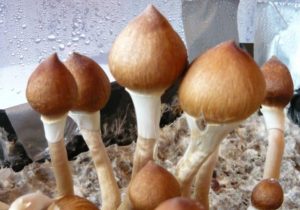

The Pink Buffalo 1 strain was first found in Thailand–according to legend, in a field where a pink buffalo was busy grazing (that sounds crazy to American ears, but actually a large minority of Thai buffalo are pink). It is one of the more potent P. cubensis varieties (as implied by the deep blue color of any cut stems), but its high is said to have a kind, gentle quality. It is relatively easy to grow—any method that works for P. cubensis will work for Pink Buffalo, but while colonization time is short, fruiting time is long, and may require cold-shocking or some other push to get pin formation started. Yields are high, and individual mushrooms can be quite large.
Purple Mystic
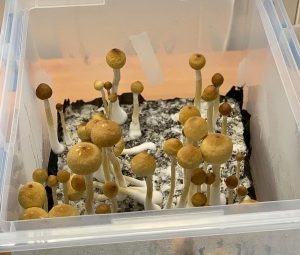

Purple Mystic[i] was found growing wild in a cow pasture in East Plant City, Florida and was then stabilized by various cultivators. The name reflects the fact that the cap is often at least partially purplish. Otherwise, it looks like a typical cube. Very little is known about this strain because most published descriptions appear to be simply repeating information supplied by the original collector, whose claims—including that Purple Mystic is the most potent strain in existence—can’t necessarily be trusted. We have not been able to track down reliable, independent information on the potency of this strain. Reports on ease of cultivation are available but conflicting, since some growers have found Purple Mystic to be fast, vigorous, and easy to work with, while others have found it slow and tricky—although once it gets established, yield is good through multiple flushes[ii].
Stargazer


We know very little about the history of Stargazers because the stories circulating about this strain have not been confirmed and might well not be true. Legends aside, the Stargazer is a fairly typical cube strain, moderate in potency but fairly easy to grow, with a tendency to produce small mushrooms in big clumps.
Any cultivation method that works with most other cube strains will do fine—but rye grain is best as an initial substrate. Colonization time and fruiting time are roughly average. Incubation temperature should be in the mid-seventies (in Fahrenheit). Yields are often excellent.
Thrasher
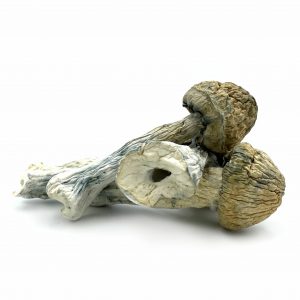

Thrasher[i] mushrooms are the offspring of Melmacs, which are the offspring of Penis Envy. They have a very thick stem and a smallish, but meaty cap, almost like Penis Envy, but in coloration they are typical cubes—pale stem that bruises blue-green, brownish cap. Thrasher has a reputation for being extremely visual, though there is reason to doubt that that the highs of different strains really vary qualitatively, or, if they do, the difference is probably swamped by all of the other factors that can influence a trip. More likely, most of the variation is simply potency. Thrasher is considered a moderately potent cube strain. It is not difficult to grow, but we wonder about its spore production, since it is shaped much like Penis Envy, which is poor at producing spores, thanks to its very narrow cap and short gills. If you want to grow this strain and can’t find spores, starting from a culture may be the better bet.
Tidal Wave
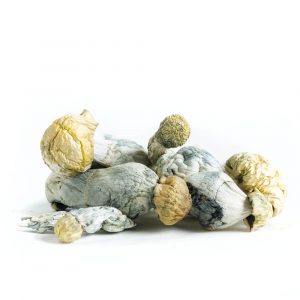

Tidal Wave is a hybrid of B+ and Penis Envy. Both are highly potent, so Tidal Wave also has a reputation for extreme potency, but actually this strain is unusually variable—some specimens may be very high potency, while others are moderate or low, making estimating proper dose sizes very difficult. Tidal Wave has simply not been stabilized genetically. Not only is the potency variable, but so are size and shape. Weird variants, such as blobs, are common. The caps are generally wavy-edged at maturity, hence the name. The strain is not usually recommended for inexperienced growers, but deep expertise is not necessary. Cultivation and fruiting times are both short, and the strain is contamination-resistant.
Treasure Coast
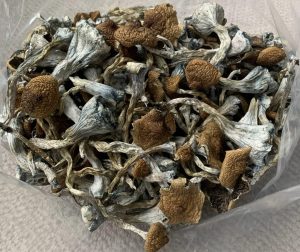

Treasure Coast was, according to legend, collected along the Treasure Coast region of Florida, but who collected it and who stabilized it and when has been lost to history. And legend may not always be factual—legend has it that Treasure Coast strain is extremely potent, but so far it has tested out as average—not that an average cube is bad!
This strain is pretty typical looking in terms of its color and shape. It is usually small, but can produce rare giants. It is the parent strain of Albino Treasure Coast, which is not albino but rather leucistic. Treasure Coast grows best on either rye grain or brown rice flour. Its short colonization time makes it resistant to contamination. The first flush is usually poor, but second and third flushes are impressive.
Trinity
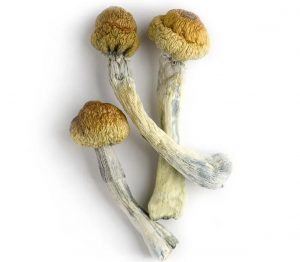

Trinity Shrooms are so called because they descend from three other well-known strains—but nobody seems ale to agree on which three. One was Penis Envy. The other two weren’t. It does look like Penis Envy, but is not quite as phallic. Trinity is a relatively new strain, so not much is known about it, but it does seem clear that Trinity is an unusually potent strain. Trinity is said to offer an intense, very visual but very clear-minded experience grounded in bodily sensations. It has been compared favorably to Z-Strain, though it is not so cerebral . However, whether strains differ in their effects is debatable.
True Albino Teacher
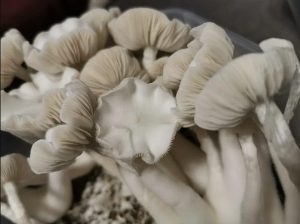

The True Albino Teacher[i], or “TAT,” is an albino version of the popular Golden Teacher. Being a true albino, not merely pale, it even has unpigmented spores. Though not otherwise identical to Golden Teacher, TAT does show a family resemblance to its parent. According to legend, it was a spontaneous mutation that growers then stabilized, though there isn’t much documentation of the strain’s history. Potency varies from only slightly above average to extremely potent, making it difficult to calculate proper doses. Since unpleasant, even dangerous side effects are much more likely at higher doses, it’s important to err on the side of taking too little rather than taking too much. You can always take more later if you want. Or, you could powder a large batch, stir the powder, then use trial and error to establish doses sided. Then use the rest of the batch to make candies. Since each candy has the same amount, dosing becomes easy. TATs are difficult to grow. If you do not yet have advanced cultivation skills, you’ll need to buy or hope a friend shares.
White Rabbit
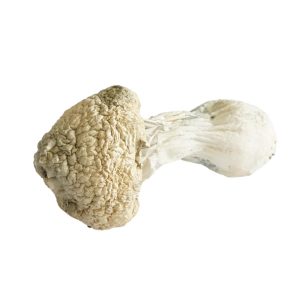

White Rabbit[i][ii] is a deliberate hybridization of two popular strains, Albino Penis Envy (APE) and Moby Dick, the idea being to combine the high potency of the former with the easy cultivation of the latter. The high potency definitely came through, although it’s more intermediate in terms of cultivation as it can be vulnerable to contamination. Despite the multiple albinos in its ancestry (both its parents and one of its grandparents are albinos) and its pale coloration, White Rabbit is not a true albino, as its spores are pigmented, and the mushroom can develop some yellowish color if exposed to sunlight during growth. The stem is short and thick, but the cap is normal in shape. Veil remnants on the cap form spots, while the ring around the stem of mature specimens turns black with fallen spores, White Rabbit is at least said to be particularly visual and introspective. It is definitely high in potency—do not use standard cube dosing recommendations for this strain. Any cultivation method normally used for cubes will work for White Rabbit, though its favorite growth medium seems to be rye grain, followed by manure or enriched soil as a close second.
Yeti


Yeti mushrooms are a strain of Psilocybe cubensis rumored to have first appeared as a spontaneous mutation during the development of True Albino Teacher. It is a true albino, but unlike TAT, it’s not just an albino version of Golden Teacher. It has a very distinct shape and is extremely potent.
Yetis have a thick stem and a cap that never entirely opens out (a bit like Penis Envy, but not especially phallic-looking). Stem and cap are both white or bluish. The first flush usually produces small fruits, but those of subsequent flushes are larger. Its high is said to be a bit eerie, not to everyone’s taste. Yeti samples have several times tested out at about twice the potency of an average cube, which sounds great but does mean you have to measure doses very carefully—a slight error in measurement could have a big effect, and, as with all psilocybin mushrooms, unexpectedly large doses produce a significantly greater risk of unpleasant or even dangerous side-effects.
Published information on how to grow Yeti is conflicting. We are not in a position to say which of the various descriptions is correct.
Z-Strain
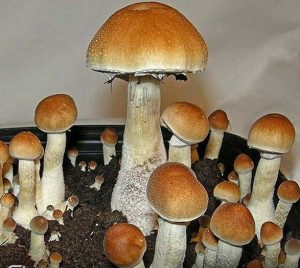

The Z-strain was intentionally developed to maximize both growth and potency. The fruiting bodies are large with unusually long stems. The strain grows fast and fruits heavily multiple times, and is therefore a favorite with commercial growers—that makes it one of the most commonly-available strains as well.
Users report high potency with a long-lasting, very visual and very euphoric trip.


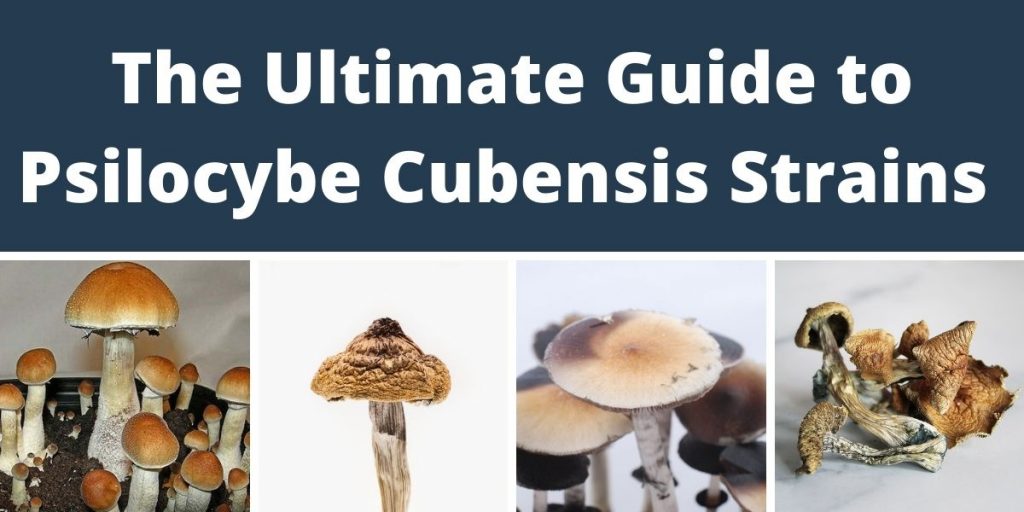

Hello, I’m wanting to speak with someone about purchasing and consulting about micro dosing with your psycillisiban mushrooms. Please let me know thank you Bonnie
Hi Bonnie,
We don’t sell Psilocybin Mushrooms. We recommend Spores101 for Psilocybin Mushrooms.
I should mention that growing these mushrooms is illegal in the US and many other countries. Therefore, all vendors will only refer to preparing psilocybes as spores, prints and mycology samples. They cannot, under penalty of law, advise anyone on how to cultivate them. This isn’t insurmountable, you just have to separate out sources to purchase from sources to advise you about growing.
“Undercover” police will sometimes call or email these companies and ask about cultivation, in order to get a criminal conviction. To ask is to put these companies in serious criminal jeopardy. Please avoid asking. You can find plenty of advice for free from people and companies that don’t sell.
BRAVO well said
legal here in colorado now
Thank you for the information. Two comments: the strongest strain, as per Paul Stamets, is P. azurescens. To quote Stamets: “Sometimes you take a gram and wonder if it was too much.” Also, it’s Terence and not Terrence.
There’s a couple of issues with naming P. Azurenscens. Firstly, the word “strain” is commonly misused in the mushroom world, including this article. It’s used to refer to different breeds of P. Cubensis. I imagine it’s because the term “strain” is used when buying and selling cannabis, and people just accept this slang usage. But, for example we don’t refer to different kinds of apples as “strains”, and scientifically speaking, we should also not call different P. Cubensis as “strains”.
As opposed to these “strains”, Azurenscens is truly a different species. All the previous ones mentioned are variations on P. Cubensis, and even the title mentions that species by name. It’s doesn’t matter a whole lot in practical terms, because P. Azurenscens is extremely difficult to cultivate. Basically it’s only foraged. If this situation changes, I’m not sure if different breeds of it will be developed and named the same way.
I’m afraid you didn’t solve this case, Sherlock! lol